Resident Crews of the Chinese Space Station Tiangong
![]()
Tiangong: Expedition 4 |
|
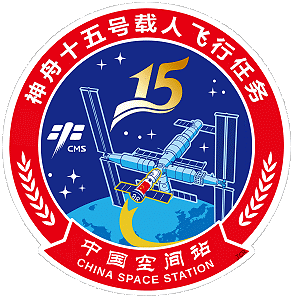 |
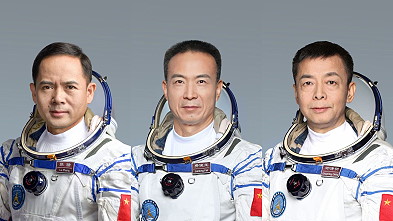 |
alternative crew photoalternative crew photo |
|
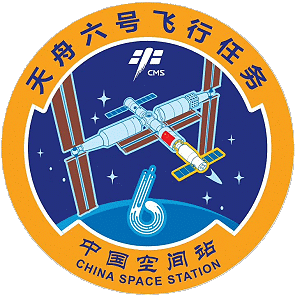 |
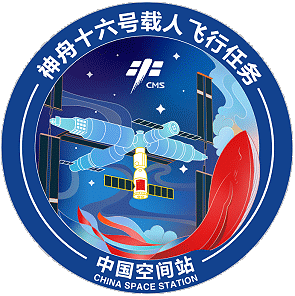 |
![]()
Crew, launch- and landing data
| No. | Nation | Surname | Given names | Position | Spacecraft (launch) |
Launch date |
Launch time |
Spacecraft (landing) |
Landing date |
Landing time |
Mission duration |
Orbits |
| 1 | Fei | Junlong | Commander | Shenzhou-15 | 29.11.2022 | 15:08:17.457 UTC | Shenzhou-15 | 03.06.2023 | 22:33 UTC | 186d 07h 24m 43s | 2931 | |
| 2 | Deng | Qingming | Astronaut | Shenzhou-15 | 29.11.2022 | 15:08:17.457 UTC | Shenzhou-15 | 03.06.2023 | 22:33 UTC | 186d 07h 24m 43s | 2931 | |
| 3 | Zhang | Lu | Astronaut | Shenzhou-15 | 29.11.2022 | 15:08:17.457 UTC | Shenzhou-15 | 03.06.2023 | 22:33 UTC | 186d 07h 24m 43s | 2931 | |
| 4 | Jing | Haipeng | Astronaut | Shenzhou-16 | 30.05.2023 | 01:31:13.480 UTC | Shenzhou-16 | 31.10.2023 | 00:11:32 UTC | 153d 22h 40m 19s | 2429 | |
| 5 | Gui | Haichao | Astronaut | Shenzhou-16 | 30.05.2023 | 01:31:13.480 UTC | Shenzhou-16 | 31.10.2023 | 00:11:32 UTC | 153d 22h 40m 19s | 2429 | |
| 6 | Zhu | Yangzhu | Astronaut | Shenzhou-16 | 30.05.2023 | 01:31:13.480 UTC | Shenzhou-16 | 31.10.2023 | 00:11:32 UTC | 153d 22h 40m 19s | 2429 |
Backup Crew
| No. | Nation | Surname | Given names | Position |
| 1 | Commander | |||
| 2 | Astronaut | |||
| 3 | Astronaut | |||
| 4 | Astronaut | |||
| 5 | Astronaut | |||
| 6 | Astronaut |
Expedition Report
|
Expedition 4 began with the undocking of
Shenzhou-14. This year, only one Tianzhou cargo spacecraft will be launched to the Chinese space station. Starting from Tianzhou-6, cargo ships have optimized and upgraded the layout of equipment and cargo holds. The improved airtight compartment cargo transport capacity will be further improved. Each launch of a fully sealed cargo ship can deliver for 3 months more food for astronauts. The Tianzhou cargo spacecraft has a maximum take-off mass of 13.5 tons, a maximum uplink cargo mass of 7 tons, and a propellant replenishment capacity of 2.5 tons. In addition to assembling and unlocking equipment in the laboratory cabinets of the Mengtian science module, the first tasks included, above all, conducting cell biological and botanical experiments with organisms that had been brought to the station with Shenzhou-15 and had a limited lifespan. New vegetables were also sown, which in addition to their function as food supplements also served as decoration. On January 07, 2023, an energetic particle detector designed and built by the National Center for Space Science was installed on the outer wall of the lock section at the rear of the Wentian Science Module. The cargo lock of the science module Mengtian was used for the first time. The astronauts placed the device in the airlock and grabbed it from the outside with the Wentian science module's small but precise mechanical arm, which was coupled with the Tianhe core module's large arm to form a long arm with a range of 14.5 m. They lifted the detector to the far end of the space station and slid it into its slot. All four measuring modules of the detector (medium-energy protons, medium-energy electrons, neutrons, particles of all kinds) functioned perfectly. The Feitian EVA suit operates with an internal pressure of 40 kPa. This has the advantage that a decompression only takes 30 minutes, but every movement is strenuous. After climbing 50 to 60 meters along the space station, the astronauts have to take a breather halfway. The first spacewalk performed Fei Junlong and Zhang Lu on February 09, 2023 (7h 06m). Deng Qingming assisted the pair from inside the Tianhe core module. Installing the first additional pump block of the thermal control system and attaching the first external platform to the Mengtian module of Tiangong Station Fei Junlong, who was the first to exit the personnel airlock in the Wentian science module, was carried by the station's two mechanical arms, coupled together to form a long arm, to the deployment site at the Mengtian science module, taking a pump unit to be installed there with him, while Zhang Lu worked on the along the module climbed along. After installation, Fei Junlong and Zhang Lu had to dismantle two foot anchoring platforms on the Tianhe module and reattach them to the Mengtian module. The second spacewalk performed again Fei Junlong and Zhang Lu on February 28, 2023 (7h 50m). However, no mentioning of the start time and end time. Later it was revealed that they installed an instrument with 20 plugs during their 2nd and most secret spacewalk. Fei Junlong had to connect almost 40 data lines to the Tianhe module. This required removing a protective cap from each socket and then inserting a rectangular plug with almost 50 contacts into the respective socket. Without spacewalking, a plasma detector was brought out through the cargo hatch and placed in its slot on the Wentian science module. Acquired from the National Center for Space Sciences, the device features a flip-out Langmuir probe to measure electron density and electron temperature and related parameters for ions. With the ion imager, a three-dimensional representation of the ion distribution in the orbit of the space station can be generated. The composition and speed of the plasma as well as the electrical potential, i.e. the electrical charge on the outer wall of the space station, which leads to the erosion of the material in the long term, are measured. The device will also be used to document the disturbances and changes in the ionosphere at mid and low latitudes in order to improve the model of the area of the ionosphere. The third spacewalk performed again Fei Junlong and Zhang Lu on March 30, 2023 (~7h 30m). However, no mentioning of the start time and end time. Later it was revealed that they connected inter-module cables. To do this, the astronauts had to establish more than 40 connections between the Wentian and Mengtian modules. According to China 'N Asia Spaceflight (https://twitter.com/CNSpaceflight) the Chinese space station Tiangong is so cramped that Shenzhou-15's main tasks were to dump trash bags during spacewalks. Although it's been a normal operation in ISS, China had to keep it secret to avoid worsening its reputation earned by CZ5B reentries & inland falling of rocket stages. The fourth spacewalk performed again Fei Junlong and Zhang Lu on April 15, 2023 (~7h 30m). However, no mentioning of the start time and end time. Installing the second additional pump block of the thermal control system and attaching the second external platform to the Mengtian module of Tiangong Station. Support struts and a pump block for heat and humidity control had to be mounted on the opened platforms of the Wentian module. Tianzhou-5 cargo spaceship separated from Tiangong at 07:25 UTC on May 05, 2023. It has switched to independent flight mode. The unmanned freighter Tianzhou-6 launched on May 10, 2022 at 13:22:51.405 UTC from the Wenchang Spacecraft Launch Site and docked to Tiangong at 21:16 UTC. Tianzhou-6 cargo spacecraft carried several cube sats to China Space Station. Among the science payloads were hydrogen fuel cell and tumor 3D model printing and culture. Tianzhou-6 has a pressurized volume of 22.5 m3, up from 18.1 m3 of previous ships. This is achieved by moving some devices previously mounted in the cargo module to the service module and will enable Tianzhou-6 to deliver about 7.4 tons supply to Tiangong Station, including 70 kg fruits. Shenzhou-16 launched on May 30, 2023 at 01:31:13.480 UTC and docked at 08:29 UTC with the Chinese space station Tiangong. The crew of Shenzhou-15 handed over the control of Tiangong to the crew of Shenzhou-16 on June 02, 2023. Tiangong Expedition 4 concluded with undocking of Shenzhou-15. |
EVA data
| Name | Start | End | Duration | Mission | Airlock | Suit | |
| EVA | Fei Junlong | 09.02.2023, 09:10 UTC | 09.02.2023, 16:16 UTC | 7h 06m | Shenzhou-15 | Wentian | Feitian-2 a (red) |
| EVA | Zhang Lu | 09.02.2023, 09:10 UTC | 09.02.2023, 16:16 UTC | 7h 06m | Shenzhou-15 | Wentian | Feitian-2 b (blue) |
| EVA | Fei Junlong | 28.02.2023, ??:?? UTC | 28.02.2023, ??:?? UTC | 7h 50m | Shenzhou-15 | Wentian | Feitian-2 a (red) |
| EVA | Zhang Lu | 28.02.2023, ??:?? UTC | 28.02.2023, ??:?? UTC | 7h 50m | Shenzhou-15 | Wentian | Feitian-2 b (blue) |
| EVA | Fei Junlong | 30.03.2023, ??:?? UTC | 30.03.2023, ??:?? UTC | ~7h 30m | Shenzhou-15 | Wentian | Feitian-2 a (red) |
| EVA | Zhang Lu | 30.03.2023, ??:?? UTC | 30.03.2023, ??:?? UTC | ~7h 30m | Shenzhou-15 | Wentian | Feitian-2 a (blue) |
| EVA | Fei Junlong | 15.04.2023, ??:?? UTC | 15.04.2023, ??:?? UTC | ~7h 30m | Shenzhou-15 | Wentian | Feitian-2 a (red) |
| EVA | Zhang Lu | 15.04.2023, ??:?? UTC | 15.04.2023, ??:?? UTC | ~7h 30m | Shenzhou-15 | Wentian | Feitian-2 a (blue) |
Photos / Graphics
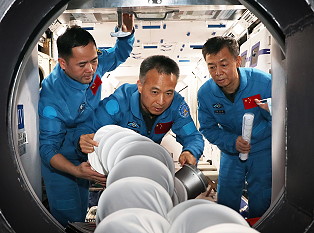 |
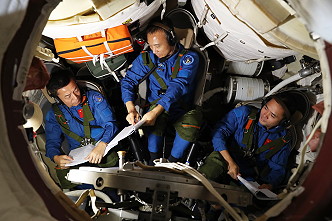 |
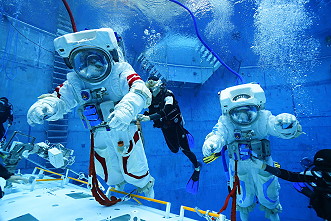 |
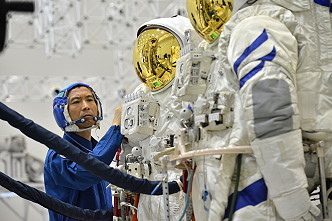 |
 |
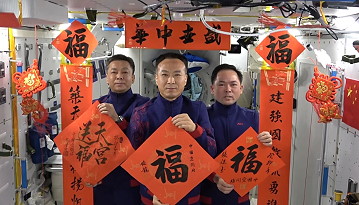 |
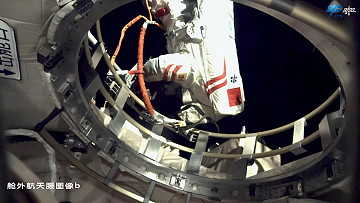 |
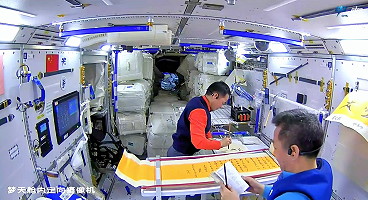 |
 |
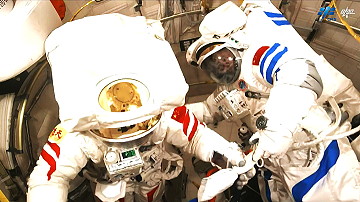 |
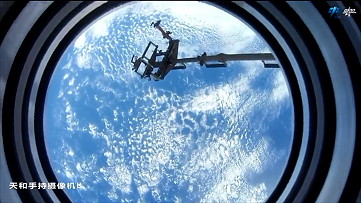 |
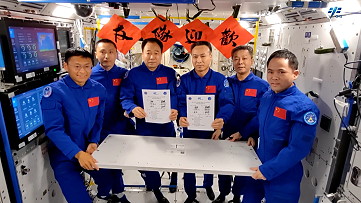 |
onboard photos |
|
more EVA photos |
|
| © |  |
Last update on March 07, 2024.  |
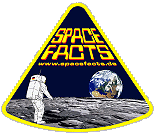 |